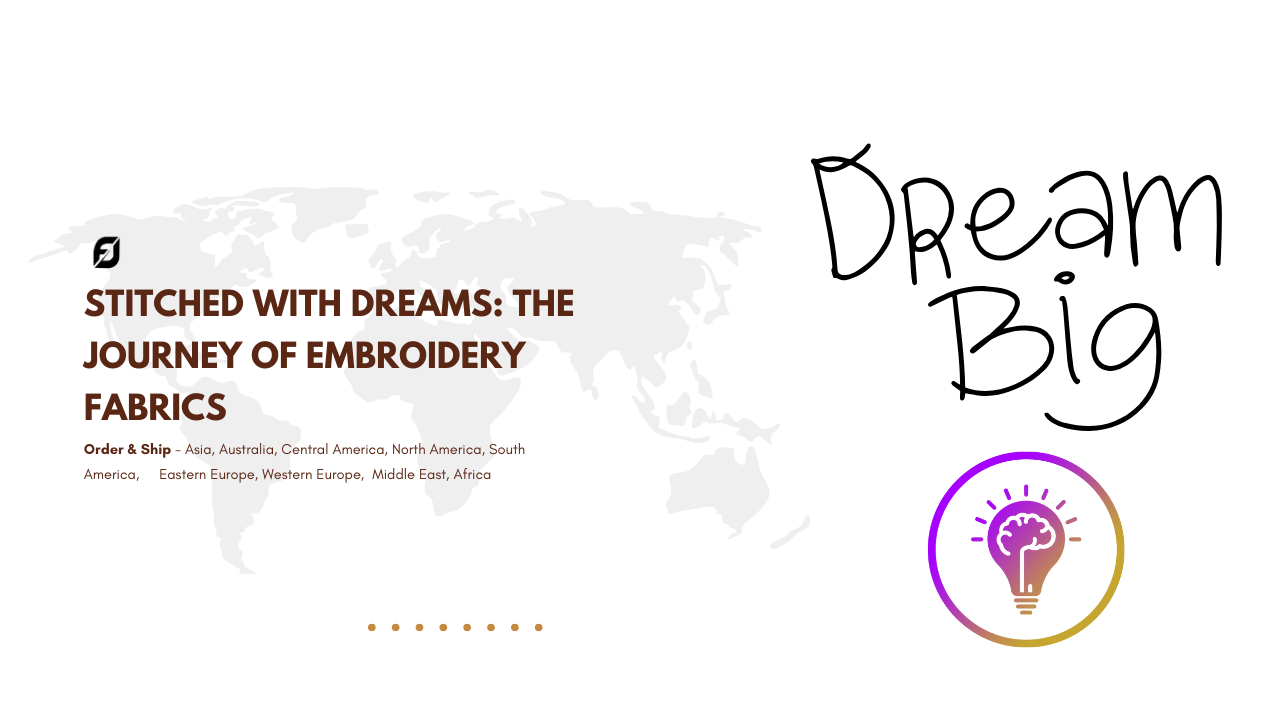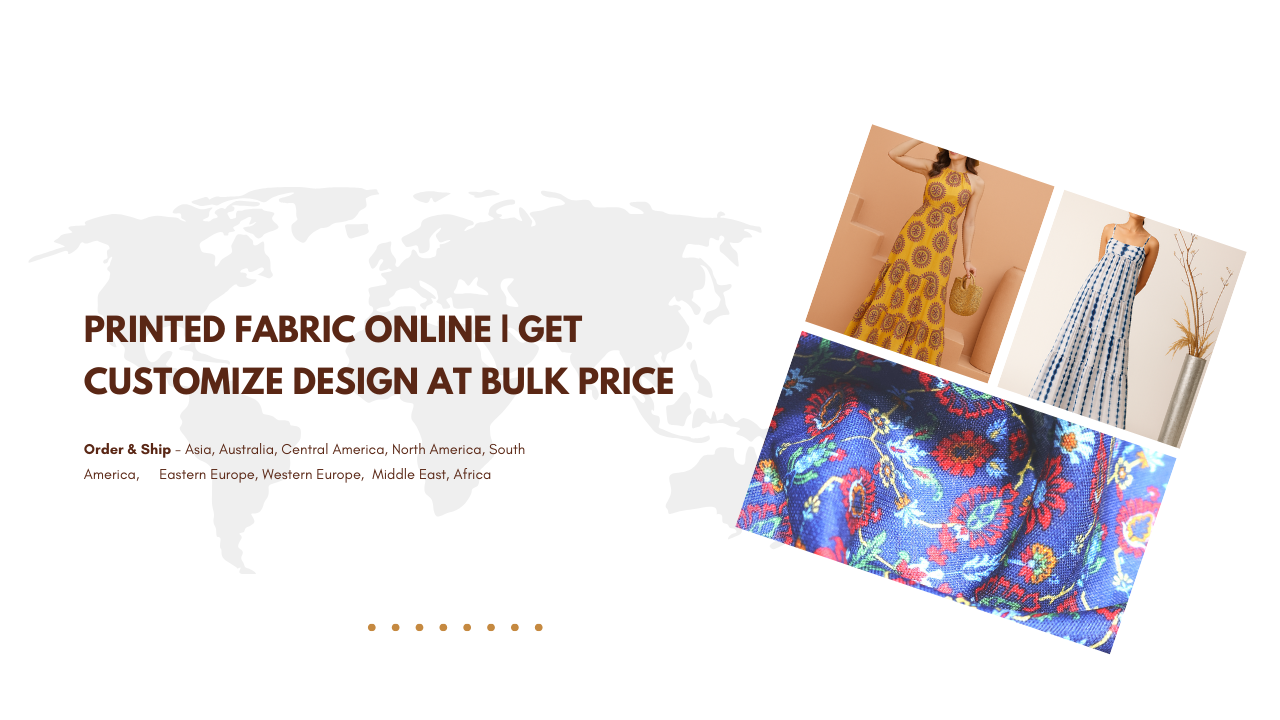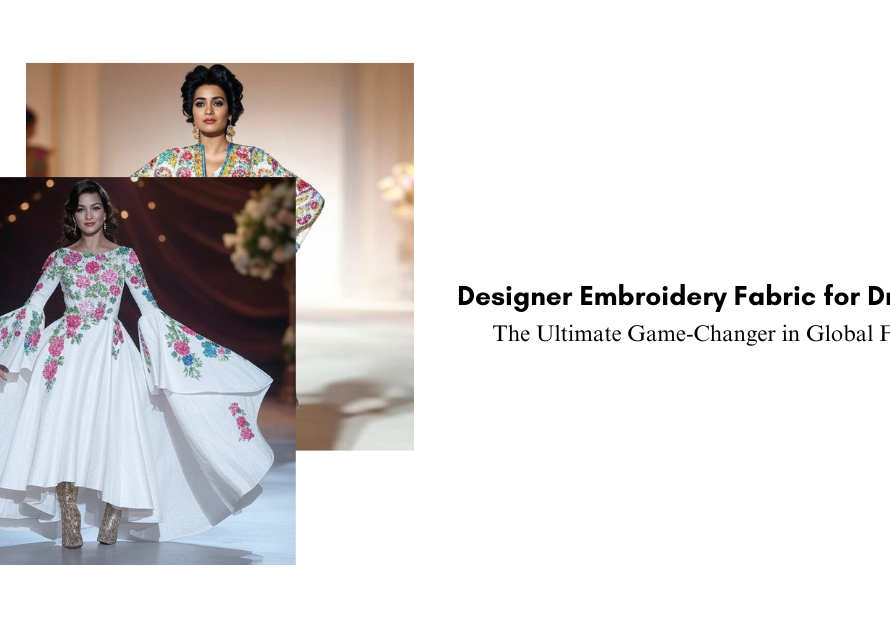Embroidery is an integral part of the textile industry, offering intricate and stunning designs that elevate any fabric.
The rich heritage of embroidery in different regions has given rise to various unique patterns that are widely used in modern and traditional fashion. Below, we explore some of the most popular embroidery patterns and their uses in fashion:
Exploring the Diversity of Embroidery Patterns in Fashion
1. Allover Embroidery Design (Embroidery Patterns)
Use: As the name suggests, allover embroidery covers the entire fabric with intricate designs. This pattern is commonly used in lehengas, sarees, kurtis, and dress materials where uniformity and extensive detailing are desired. It creates a rich, ornate look, making the garment suitable for weddings, festive occasions, and high-end fashion.
2. Kali Embroidery Design (Embroidery Patterns)
Use: Kali embroidery is often found in lehengas, Anarkali suits, and garments with flared silhouettes. The vertical designs run along the length of the fabric, adding volume and enhancing the garment’s flow. This pattern is ideal for creating an elegant and grand appearance, especially in traditional wear.
3. Daman Embroidery Design (Embroidery Patterns)
Use: Daman embroidery is specifically applied to the hemline of kurtis, sarees, and dresses. This embroidery enriches the lower portion of the garment, giving it a distinctive and eye-catching look. It is particularly popular in festive and formal wear, adding a touch of sophistication and charm to the outfit.
4. Mirror Work Embroidery (Embroidery Patterns)
Use: Mirror work embroidery, primarily from Rajasthan and Gujarat, involves attaching small mirrors onto the fabric, creating a vibrant and reflective effect. This pattern is widely used in traditional outfits like ghagra cholis, kurtis, and dupattas. Mirror work adds sparkle and brightness, making it a perfect choice for festive and bridal wear.
5. Butti Embroidery Design (Embroidery Patterns)
Use: Butti embroidery features small, scattered motifs across the fabric. This pattern is commonly used in kurtis, sarees, and lehengas, offering a subtle yet elegant look. Butti designs are ideal for both everyday wear and formal occasions, providing a refined and understated elegance.
6. Sequins Embroidery Design (Embroidery Patterns)
Use: Sequins embroidery involves stitching small, shiny discs onto the fabric to create dazzling designs. This pattern is prevalent in lehengas, gowns, and sarees, especially for party wear and festive attire. Sequins add glamour and glitz, making the garment stand out in any event.
7. Beads Embroidery Design (Embroidery Patterns)
Use: Beads embroidery uses small beads to create intricate patterns on the fabric. This type of embroidery is commonly found in evening gowns, lehengas, and sarees, perfect for parties and weddings. Beads add a luxurious and opulent feel to the garment, making it look regal and elegant.
8. Zari Work Embroidery Design (Embroidery Patterns)
Use: Zari work, involving gold or silver threads, is one of the most exquisite forms of embroidery. It is often seen in traditional Indian attire like Banarasi sarees, lehengas, and sherwanis. Zari work imparts a royal and majestic appearance, making it a popular choice for bridal wear and special occasions.
9. Foil Work Embroidery Design (Embroidery Patterns)
Use: Foil work embroidery uses metallic sheets that are adhered to the fabric to create shiny, reflective designs. This modern pattern is popular in gowns, sarees, and lehengas, offering a chic and stylish look. Foil work is perfect for fashion-forward outfits that demand attention and shine.
10. Appliqué Work Embroidery (Embroidery Patterns)
Use: Appliqué work involves sewing fabric patches onto a base fabric to create decorative designs. This type of embroidery is versatile and can be used in a wide range of garments, from casual wear to elaborate gowns. Appliqué adds texture and depth to the garment, making it visually interesting and unique.
11. Aari Embroidery (Embroidery Patterns)
Use: Aari embroidery, also known as hook embroidery, uses a special needle called an ‘aari.’ This intricate and delicate technique is often used on bridal wear, sarees, and high-end fashion garments. The detailed work makes the garment look rich and luxurious, perfect for special occasions.
12. Chikankari Embroidery (Embroidery Patterns)
Use: Chikankari is a traditional embroidery from Lucknow, India, known for its delicate and intricate white thread work on soft fabrics like muslin. This pattern is perfect for summer wear, ethnic outfits, and formal attire, providing a sophisticated and graceful appearance.
13. Phulkari Embroidery
Use: Originating from Punjab, Phulkari embroidery is known for its bright and vibrant floral designs. It is commonly used in dupattas, shawls, and traditional Punjabi suits. Phulkari adds a burst of color and life to any outfit, making it ideal for festivals and celebrations.
14. Kantha Embroidery
Use: Kantha embroidery, hailing from Bengal and Odisha, involves simple, running stitches to create elaborate patterns. This style is often seen on sarees, quilts, and shawls, offering a rustic and artistic look. Kantha is perfect for casual and artistic garments that emphasize handcrafted beauty.
15. Gota Patti Work
Use: Gota Patti is a traditional Rajasthani embroidery that uses gold and silver ribbons to create intricate patterns. It is often used in bridal wear, lehengas, sarees, and festive attire. Gota Patti adds a rich and festive touch, making the garment opulent and grand.
16. Cutwork Embroidery (Chiffli Work)
Use: Cutwork embroidery involves cutting portions of the fabric and stitching the edges to create delicate designs. This type of embroidery is popular in sarees, kurtis, and dress materials, offering a sophisticated and intricate look that is ideal for formal and semi-formal wear.
17. Resham Embroidery
Use: Resham embroidery, done with silk threads, is known for its smooth and glossy finish. It is often seen in sarees, lehengas, and ethnic wear, providing a luxurious and elegant appearance. This embroidery is perfect for both casual and formal occasions, adding a touch of refinement to the garment.
18. Patchwork Embroidery
Use: Patchwork embroidery involves stitching different fabric pieces together to create a design. This style is often used in quilts, jackets, and ethnic wear. Patchwork adds a playful and eclectic look, making it perfect for casual and creative outfits.
19. Pashmina Embroidery
Use: Pashmina embroidery is famous for its fine and intricate designs, typically found on Pashmina shawls. This pattern is perfect for winter wear and special occasions, offering warmth and elegance. Pashmina embroidery adds a touch of luxury to any garment.
These embroidery patterns are not just decorative elements but also carry cultural significance and craftsmanship. Each pattern has its unique charm, making it a vital part of fashion across different occasions and styles.
_______________________________
1. What is the significance of Allover Embroidery in fashion, and where is it commonly used?
Allover embroidery is a highly intricate design pattern that covers the entire fabric with continuous motifs or designs. This pattern is significant in fashion for its ability to create a rich, opulent look that is both uniform and detailed. Allover embroidery is often used in garments that require a luxurious and grand appearance, such as lehengas, sarees, and heavily embroidered kurtis. It is especially popular in bridal wear and festive attire, where the emphasis is on creating a statement look. The continuous pattern across the fabric adds a sense of harmony and elegance, making it ideal for high-end fashion. Additionally, allover embroidery is versatile, as it can be crafted using various materials like silk threads, zari, and beads, depending on the desired effect. This type of embroidery is not only visually appealing but also adds texture and depth to the fabric, making it a favorite choice for designers looking to create garments that stand out in any event or occasion.
2. How does Kali Embroidery enhance the look of traditional garments like Anarkali suits?
Kali embroidery is a specialized pattern that runs vertically along the length of the fabric, typically used in garments with flared silhouettes like Anarkali suits and lehengas. This embroidery pattern plays a crucial role in enhancing the overall look of traditional garments by adding volume and movement. The vertical lines of embroidery create an illusion of height and elongation, which is particularly flattering for such outfits. Kali embroidery is often characterized by its detailed and intricate work, which adds richness and depth to the fabric. In Anarkali suits, the flared design is accentuated by the Kali embroidery, making the garment flow gracefully and elegantly. This type of embroidery is perfect for festive and formal occasions, as it adds a touch of grandeur and sophistication to the outfit. Whether it’s done in vibrant colors or subtle tones, Kali embroidery ensures that the garment stands out, making it a popular choice among those looking to make a statement with their traditional attire.
3. What makes Daman Embroidery a popular choice for enhancing the hemline of garments?
Daman embroidery is a specific type of embroidery that focuses on decorating the hemline of garments, such as kurtis, sarees, and dresses. This embroidery pattern is popular for its ability to add a distinctive and eye-catching element to the lower portion of the garment, creating a balanced and harmonious look. The hemline is often the focal point of a garment, and Daman embroidery enhances this area with intricate and detailed designs. This type of embroidery is ideal for adding a touch of elegance and sophistication to the outfit, making it suitable for both casual and formal wear. Daman embroidery can be done in a variety of styles, from traditional motifs to contemporary designs, depending on the desired look. It is often complemented by matching or contrasting embroidery on other parts of the garment, creating a cohesive and polished appearance. The addition of Daman embroidery to a garment not only enhances its aesthetic appeal but also adds a sense of luxury and refinement, making it a popular choice among fashion enthusiasts.
4. How does Mirror Work Embroidery contribute to the vibrancy of traditional Indian outfits?
Mirror work embroidery is a traditional Indian craft that involves attaching small mirrors to the fabric, creating a vibrant and reflective effect. This embroidery pattern is particularly popular in regions like Rajasthan and Gujarat, where it is used extensively in traditional outfits such as ghagra cholis, kurtis, and dupattas. The mirrors, often surrounded by colorful thread work, catch and reflect light, adding a lively and festive feel to the garment. Mirror work embroidery is not only visually striking but also culturally significant, representing the rich heritage of Indian craftsmanship. It is commonly used in festive and bridal wear, where the emphasis is on creating a bright and celebratory look. The reflective quality of the mirrors adds a dynamic element to the outfit, making it stand out in any setting. This embroidery is versatile and can be combined with other techniques like zari work, beadwork, or sequins, further enhancing the overall appearance of the garment. Mirror work embroidery continues to be a favorite among designers and fashion lovers for its ability to add sparkle and vibrancy to traditional attire.
5. What is Butti Embroidery, and how does it add elegance to garments?
Butti embroidery is a pattern characterized by small, scattered motifs or “buttis” across the fabric. These motifs are usually spaced evenly, creating a subtle yet elegant design. Butti embroidery is popular in garments like kurtis, sarees, and lehengas, where a delicate and refined look is desired. The simplicity of the butti pattern makes it versatile, suitable for both everyday wear and special occasions. Each butti can be crafted using various materials such as silk threads, zari, or beads, depending on the desired effect. The scattered motifs add a touch of sophistication to the garment without overwhelming the overall design. This type of embroidery is particularly favored for its understated beauty, allowing the fabric and the craftsmanship to shine without being overly ornate. Butti embroidery is also versatile in terms of color combinations, as it can be done in contrasting or tonal shades to suit different tastes and preferences. The elegance and versatility of butti embroidery make it a timeless choice in fashion, appealing to those who appreciate subtlety and refinement in their attire.
6. How does Sequins Embroidery enhance the glamour quotient of party wear?
Sequins embroidery involves stitching small, shiny discs (sequins) onto the fabric to create dazzling designs. This type of embroidery is highly popular in party wear, such as gowns, sarees, and lehengas, where a glamorous and eye-catching look is desired. The reflective nature of sequins adds sparkle and shimmer to the garment, making it perfect for evening events and festive occasions. Sequins embroidery can be done in various patterns, from simple scattered designs to intricate motifs, depending on the desired level of embellishment. The versatility of sequins allows for creative expression, enabling designers to craft garments that are both stylish and unique. This embroidery pattern is often combined with other techniques like beadwork, zari, or thread embroidery to enhance the overall effect. Sequins embroidery is not just limited to traditional wear; it is also widely used in contemporary fashion, including cocktail dresses, jackets, and accessories. The glamour and elegance that sequins embroidery brings to a garment make it a go-to choice for those looking to make a statement at any special event.
7. What is Beads Embroidery, and why is it a preferred choice for creating luxurious garments?
Beads embroidery is a technique that involves stitching small beads onto fabric to create intricate and decorative patterns. This type of embroidery is often used in luxurious garments such as evening gowns, lehengas, sarees, and bridal wear, where a rich and opulent look is desired. The use of beads adds texture, depth, and a three-dimensional effect to the fabric, making it stand out and look more elaborate. Beads embroidery can range from simple, delicate designs to complex and highly detailed motifs, depending on the size, color, and type of beads used. This embroidery is often combined with other techniques such as sequins, zari, or thread work to enhance the overall design. The versatility of beads embroidery allows for a wide range of creative possibilities, enabling designers to craft garments that are both elegant and luxurious. The addition of beads to a garment not only enhances its aesthetic appeal but also adds a tactile quality, making it feel more special and exclusive. Beads embroidery is a preferred choice for those looking to create garments that exude luxury and sophistication.
8. What makes Zari Work Embroidery a timeless choice in traditional Indian attire?
Zari work embroidery, involving the use of gold or silver threads, is one of the most exquisite and timeless forms of embroidery in traditional Indian attire. This type of embroidery is known for its rich and luxurious appearance, making it a popular choice for bridal wear, sarees, lehengas, and sherwanis. Zari work is deeply rooted in Indian culture and has been a symbol of opulence and grandeur for centuries. The intricate designs created with zari threads add a royal and majestic touch to the garment, making it suitable for special occasions like weddings, festivals, and formal events. Zari work can be done in various styles, including floral motifs, geometric patterns, and elaborate borders, depending on the garment’s design and the desired effect. The versatility of zari work allows it to be combined with other embroidery techniques like beadwork, sequins, or mirror work, enhancing the overall richness of the garment. The timeless appeal of zari work lies in its ability to add elegance and sophistication to any outfit, making it a cherished choice for generations.
9. How does Appliqué Work Embroidery add creativity and texture to fashion garments?
Appliqué work embroidery is a technique that involves sewing fabric patches onto a base fabric to create decorative designs. This embroidery style is known for adding creativity, texture, and depth to fashion garments, making them visually interesting and unique. Appliqué work is versatile and can be used in a wide range of garments, from casual wear to elaborate gowns. The patches used in appliqué can be of different shapes, sizes, and colors, allowing for endless creative possibilities. This embroidery technique is often combined with other methods like embroidery stitches, beadwork, or sequins to enhance the overall design. Appliqué work adds a tactile quality to the garment, making it feel more special and artisanal. It is particularly popular in ethnic wear, jackets, quilts, and accessories, where the emphasis is on craftsmanship and originality. The texture and dimension created by appliqué work make the garment stand out, offering a fresh and artistic approach to fashion. This embroidery style is perfect for those looking to add a touch of creativity and individuality to their wardrobe.
10. What is the appeal of Cutwork Embroidery, and where is it commonly used?
Cutwork embroidery, also known as ‘Chikan’ or ‘Chiffli,’ is a technique that involves cutting away portions of the fabric and stitching around the edges to create intricate patterns. This embroidery style is known for its delicate and airy appearance, making it a popular choice for summer wear, especially in garments like kurtis, sarees, and dresses. The appeal of cutwork embroidery lies in its ability to create elegant and detailed designs that are both lightweight and breathable. This embroidery is often done on light fabrics such as cotton, linen, or chiffon, making it perfect for warm weather. Cutwork embroidery can range from simple, geometric patterns to elaborate floral designs, depending on the garment’s style and the desired look. It is particularly favored in ethnic wear and contemporary fashion, where the emphasis is on combining tradition with modern aesthetics. The versatility and timeless charm of cutwork embroidery make it a favorite among designers and fashion enthusiasts who appreciate the blend of intricate craftsmanship and subtle elegance.






